GROMACS溶菌酶模拟
- 主要参考官方推荐的第三方教程
- 基于GROMACS 2023.2
1.准备蛋白质结构文件
(1) 将下载的pdb文件中的结晶水去除(即,删除所有包含”HOH”的行)
grep -v HOH 1aki.pdb > 1AKI_clean.pdb
(2)指定使用的水模型,生成GROMACS可用的拓扑文件
gmx pdb2gmx -f 1AKI_clean.pdb -o 1AKI_processed.gro -water spce
选择OPLS力场,之后会生成:
- 拓扑结构文件:topol.top
- 处理后的gromos87格式的分子结构文件:1AKI_processed.gro
- 位置约束文件:posre.itp
2. 生成模拟盒子
分子模拟时常使用周期边界条件来消除真空模拟带来的误差,通常做法是使用递归复制的单元盒子(unit cell)。因此此步骤需要将蛋白质放入初始的单元盒子,并且设置margin来避免计算自身的作用。
(1)将蛋白质对于盒子居中(-c),并且设置距离盒子边缘1nm(-d 1.0),使用立方体盒子(-bt cubic)
gmx editconf -f 1AKI_processed.gro -o 1AKI_newbox.gro -c -d 1.0 -bt cubic
此时生成的1AKI_newbox.gro就是将上一步生成的1AKI_processed.gro的原子位置的偏移之后的结果。
3. 添加水溶液
往盒子里添加水分子:
gmx solvate -cp 1AKI_newbox.gro -cs spc216.gro -o 1AKI_solv.gro -p topol.top
spc216.gro为gromacs内置的水分子模型文件, 此时生成的1AKI_solv.gro与1AKI_newbox.gro相比,原子数从1960增加到33892个,也就是说添加了(33895-1963)/3=10644个水分子,这点可以从topol.top文件末尾被追加的SOL来确定:
[ molecules ]
; Compound #mols
Protein_chain_A 1
SOL 10644
4. 电中性化
为了保持溶液整体的电中性,需要添加一定数量的离子。
(1)首先生成执行电中性化所需的tpr文件
gmx grompp -f ions.mdp -c 1AKI_solv.gro -p topol.top -o ions.tpr
ions.mdp文件如下:
; ions.mdp - used as input into grompp to generate ions.tpr
; Parameters describing what to do, when to stop and what to save
integrator = steep ; Algorithm (steep = steepest descent minimization)
emtol = 1000.0 ; Stop minimization when the maximum force < 1000.0 kJ/mol/nm
emstep = 0.01 ; Minimization step size
nsteps = 50000 ; Maximum number of (minimization) steps to perform
; Parameters describing how to find the neighbors of each atom and how to calculate the interactions
nstlist = 1 ; Frequency to update the neighbor list and long range forces
cutoff-scheme = Verlet ; Buffered neighbor searching
ns_type = grid ; Method to determine neighbor list (simple, grid)
coulombtype = cutoff ; Treatment of long range electrostatic interactions
rcoulomb = 1.0 ; Short-range electrostatic cut-off
rvdw = 1.0 ; Short-range Van der Waals cut-off
pbc = xyz ; Periodic Boundary Conditions in all 3 dimensions
(2)执行电中性化
gromacs的做法是将一定数量的水分子替换成离子来实现电中性。-pname指定使用钠作为正离子,-nname指定氯作为负离子 -neutral指定最终结果为中性:
gmx genion -s ions.tpr -o 1AKI_solv_ions.gro -p topol.top -pname NA -nname CL -neutral
选择SOL。观察topol.top文件的末尾SOL和CL的数量变化,可以确定8个水分子被替换成了CL离子:
[ molecules ]
; Compound #mols
Protein_chain_A 1
SOL 10636
CL 8
5. 能量最小化
初始的原子位置是随机的,如果直接开始模拟可能会产生原子距离过近而崩溃之类的问题,因此在正式模拟之前需要将整体的势能尽可能减小。
(1)生成执行最小化能量需要的tpr文件:
gmx grompp -f minim.mdp -c 1AKI_solv_ions.gro -p topol.top -o em.tpr
minim.mdp文件如下:
; minim.mdp - used as input into grompp to generate em.tpr
; Parameters describing what to do, when to stop and what to save
integrator = steep ; Algorithm (steep = steepest descent minimization)
emtol = 1000.0 ; Stop minimization when the maximum force < 1000.0 kJ/mol/nm
emstep = 0.01 ; Minimization step size
nsteps = 50000 ; Maximum number of (minimization) steps to perform
; Parameters describing how to find the neighbors of each atom and how to calculate the interactions
nstlist = 1 ; Frequency to update the neighbor list and long range forces
cutoff-scheme = Verlet ; Buffered neighbor searching
ns_type = grid ; Method to determine neighbor list (simple, grid)
coulombtype = PME ; Treatment of long range electrostatic interactions
rcoulomb = 1.0 ; Short-range electrostatic cut-off
rvdw = 1.0 ; Short-range Van der Waals cut-off
pbc = xyz ; Periodic Boundary Conditions in all 3 dimensions
(2)执行能量最小化:
gmx mdrun -v -deffnm em
(3)观察势能的变化:
gmx energy -f em.edr -o potential.xvg #选择potential
输出势能数据到xvg文件。 通常可以使用Xmgrace等,不过numpy也可以直接读取xvg文件:
import matplotlib.pyplot as plt
import numpy as np
from matplotlib.pyplot import figure
x,y = np.loadtxt("potential.xvg",comments=["@", "#"],unpack=True)
figure(figsize=(10, 7), dpi=100)
plt.ticklabel_format(axis='y', style='sci', scilimits=(0,0))
plt.ylabel("Potential Energy(kJ/mol)")
plt.xlabel("energy minimization step")
plt.plot(x,y)
plt.savefig("potential.png", format="png", dpi=300)
获得如下的势能变化曲线,可以看出势能逐渐趋近于最小值:
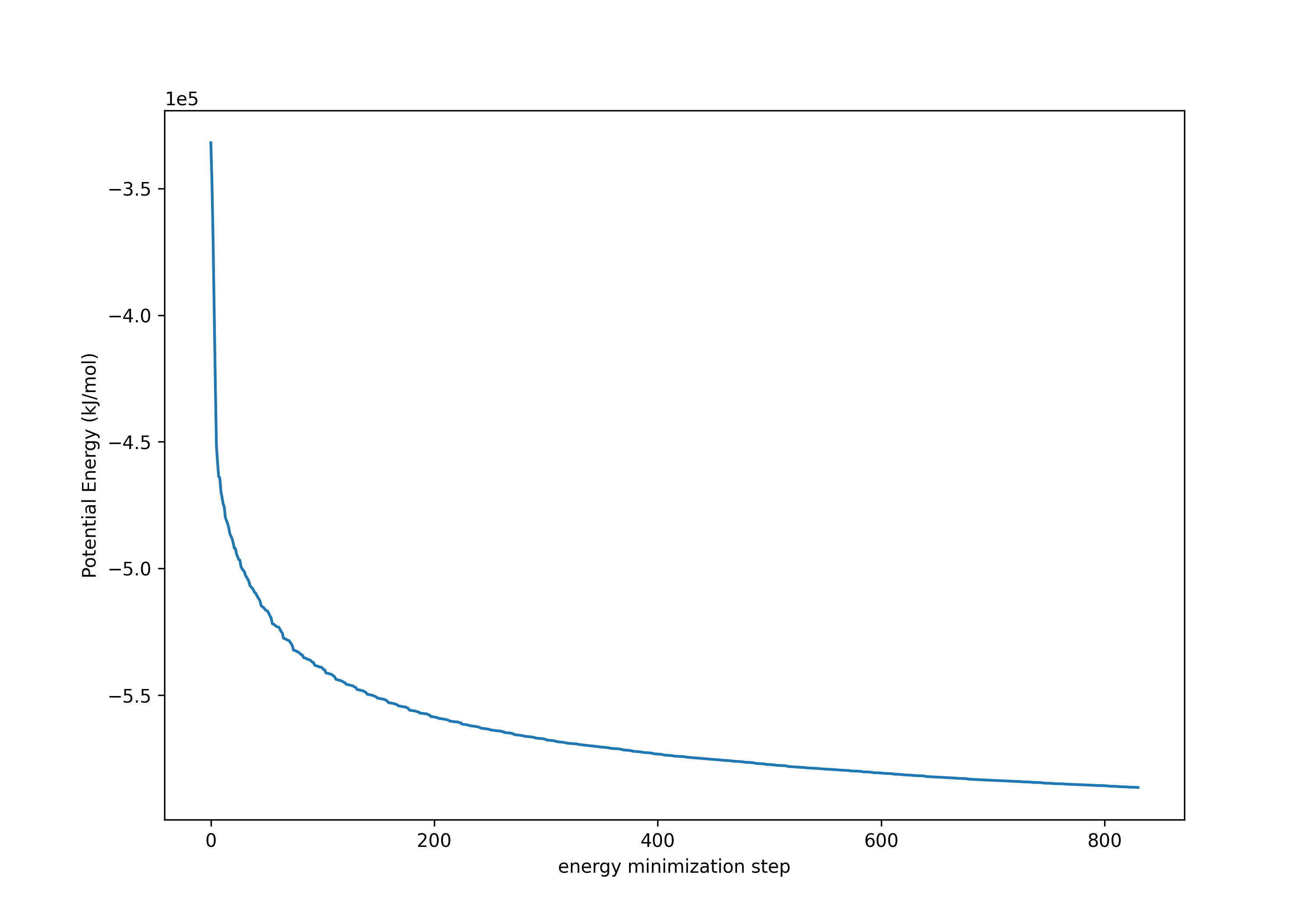
6. 平衡化
正式模拟前的最后一个步骤是执行平衡化,包括NVT平衡和NPT平衡。
(1)NVT(number-volume-temperature)平衡通过控制等温等容将系统温度调整到设定温度
gmx grompp -f nvt.mdp -c em.gro -r em.gro -p topol.top -o nvt.tpr
gmx mdrun -deffnm nvt
nvt.mdp文件如下,参考温度为300K:
title = OPLS Lysozyme NVT equilibration
define = -DPOSRES ; position restrain the protein
; Run parameters
integrator = md ; leap-frog integrator
nsteps = 50000 ; 2 * 50000 = 100 ps
dt = 0.002 ; 2 fs
; Output control
nstxout = 500 ; save coordinates every 1.0 ps
nstvout = 500 ; save velocities every 1.0 ps
nstenergy = 500 ; save energies every 1.0 ps
nstlog = 500 ; update log file every 1.0 ps
; Bond parameters
continuation = no ; first dynamics run
constraint_algorithm = lincs ; holonomic constraints
constraints = h-bonds ; bonds involving H are constrained
lincs_iter = 1 ; accuracy of LINCS
lincs_order = 4 ; also related to accuracy
; Nonbonded settings
cutoff-scheme = Verlet ; Buffered neighbor searching
ns_type = grid ; search neighboring grid cells
nstlist = 10 ; 20 fs, largely irrelevant with Verlet
rcoulomb = 1.0 ; short-range electrostatic cutoff (in nm)
rvdw = 1.0 ; short-range van der Waals cutoff (in nm)
DispCorr = EnerPres ; account for cut-off vdW scheme
; Electrostatics
coulombtype = PME ; Particle Mesh Ewald for long-range electrostatics
pme_order = 4 ; cubic interpolation
fourierspacing = 0.16 ; grid spacing for FFT
; Temperature coupling is on
tcoupl = V-rescale ; modified Berendsen thermostat
tc-grps = Protein Non-Protein ; two coupling groups - more accurate
tau_t = 0.1 0.1 ; time constant, in ps
ref_t = 300 300 ; reference temperature, one for each group, in K
; Pressure coupling is off
pcoupl = no ; no pressure coupling in NVT
; Periodic boundary conditions
pbc = xyz ; 3-D PBC
; Velocity generation
gen_vel = yes ; assign velocities from Maxwell distribution
gen_temp = 300 ; temperature for Maxwell distribution
gen_seed = -1 ; generate a random seed
观察温度变化,可以发现温度大致稳定在300K附近:
gmx energy -f nvt.edr -o temperature.xvg #选择16
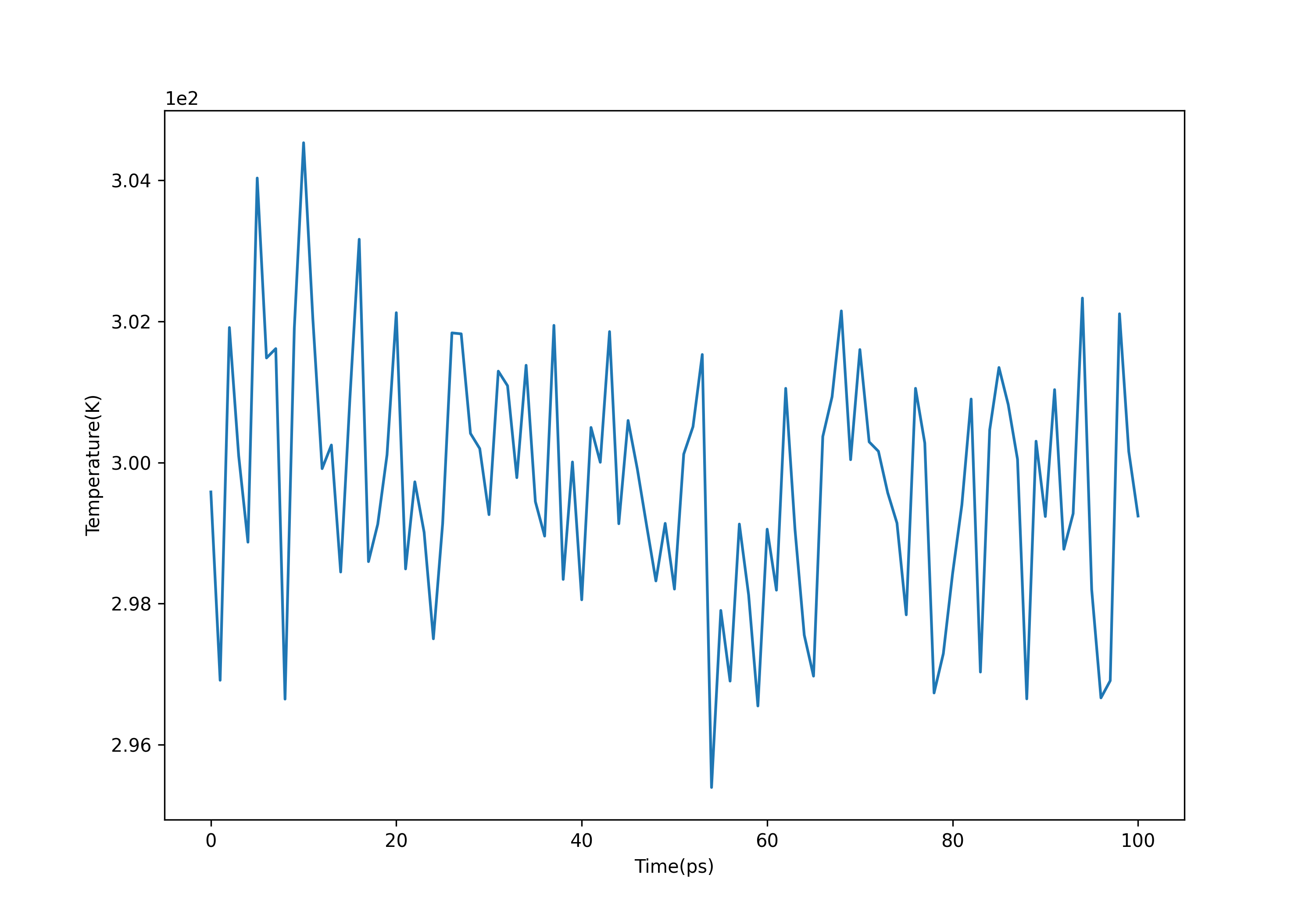 (2)NPT(number-pressure-temperature)平衡通过控制等温等压将系统压强调整到设定压强:
(2)NPT(number-pressure-temperature)平衡通过控制等温等压将系统压强调整到设定压强:
gmx grompp -f npt.mdp -c nvt.gro -r nvt.gro -t nvt.cpt -p topol.top -o npt.tpr
gmx mdrun -deffnm npt
npt.mdp文件如下,参考压强为1.0bar:
title = OPLS Lysozyme NPT equilibration
define = -DPOSRES ; position restrain the protein
; Run parameters
integrator = md ; leap-frog integrator
nsteps = 50000 ; 2 * 50000 = 100 ps
dt = 0.002 ; 2 fs
; Output control
nstxout = 500 ; save coordinates every 1.0 ps
nstvout = 500 ; save velocities every 1.0 ps
nstenergy = 500 ; save energies every 1.0 ps
nstlog = 500 ; update log file every 1.0 ps
; Bond parameters
continuation = yes ; Restarting after NVT
constraint_algorithm = lincs ; holonomic constraints
constraints = h-bonds ; bonds involving H are constrained
lincs_iter = 1 ; accuracy of LINCS
lincs_order = 4 ; also related to accuracy
; Nonbonded settings
cutoff-scheme = Verlet ; Buffered neighbor searching
ns_type = grid ; search neighboring grid cells
nstlist = 10 ; 20 fs, largely irrelevant with Verlet scheme
rcoulomb = 1.0 ; short-range electrostatic cutoff (in nm)
rvdw = 1.0 ; short-range van der Waals cutoff (in nm)
DispCorr = EnerPres ; account for cut-off vdW scheme
; Electrostatics
coulombtype = PME ; Particle Mesh Ewald for long-range electrostatics
pme_order = 4 ; cubic interpolation
fourierspacing = 0.16 ; grid spacing for FFT
; Temperature coupling is on
tcoupl = V-rescale ; modified Berendsen thermostat
tc-grps = Protein Non-Protein ; two coupling groups - more accurate
tau_t = 0.1 0.1 ; time constant, in ps
ref_t = 300 300 ; reference temperature, one for each group, in K
; Pressure coupling is on
pcoupl = Parrinello-Rahman ; Pressure coupling on in NPT
pcoupltype = isotropic ; uniform scaling of box vectors
tau_p = 2.0 ; time constant, in ps
ref_p = 1.0 ; reference pressure, in bar
compressibility = 4.5e-5 ; isothermal compressibility of water, bar^-1
refcoord_scaling = com
; Periodic boundary conditions
pbc = xyz ; 3-D PBC
; Velocity generation
gen_vel = no ; Velocity generation is off
观察压强变化,可以发现压强虽然波动很大,但是总体在1.0bar附近波动:
gmx energy -f npt.edr -o pressure.xvg #选择18
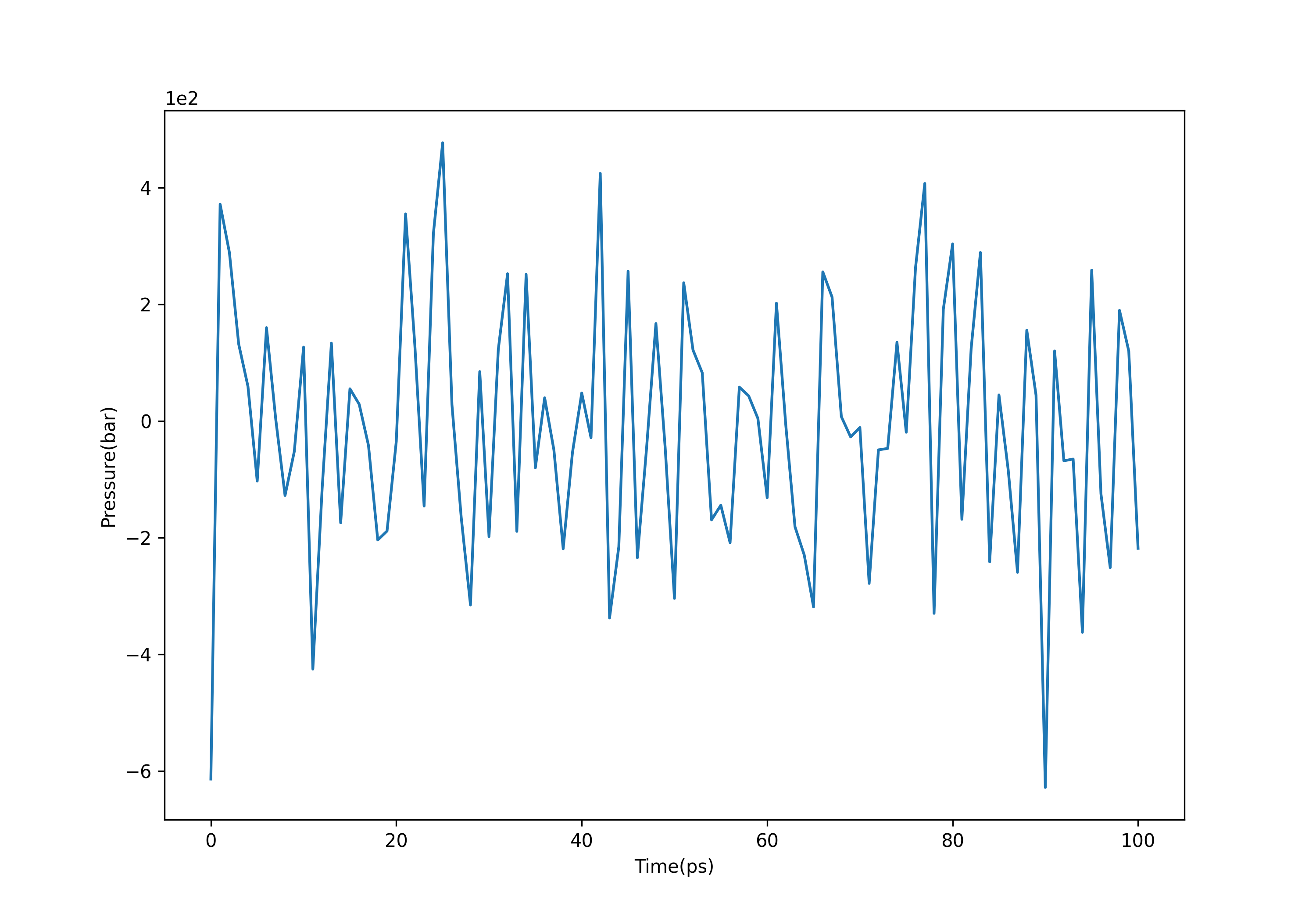 (3)观察密度变化
(3)观察密度变化
整体的密度大致在1.018kg/m^3附近波动,和室温中的水的密度(1kg/m^3)以及SPC/E水的密度(1.008kg/m^3)基本一致:
gmx energy -f npt.edr -o density.xvg #选择24
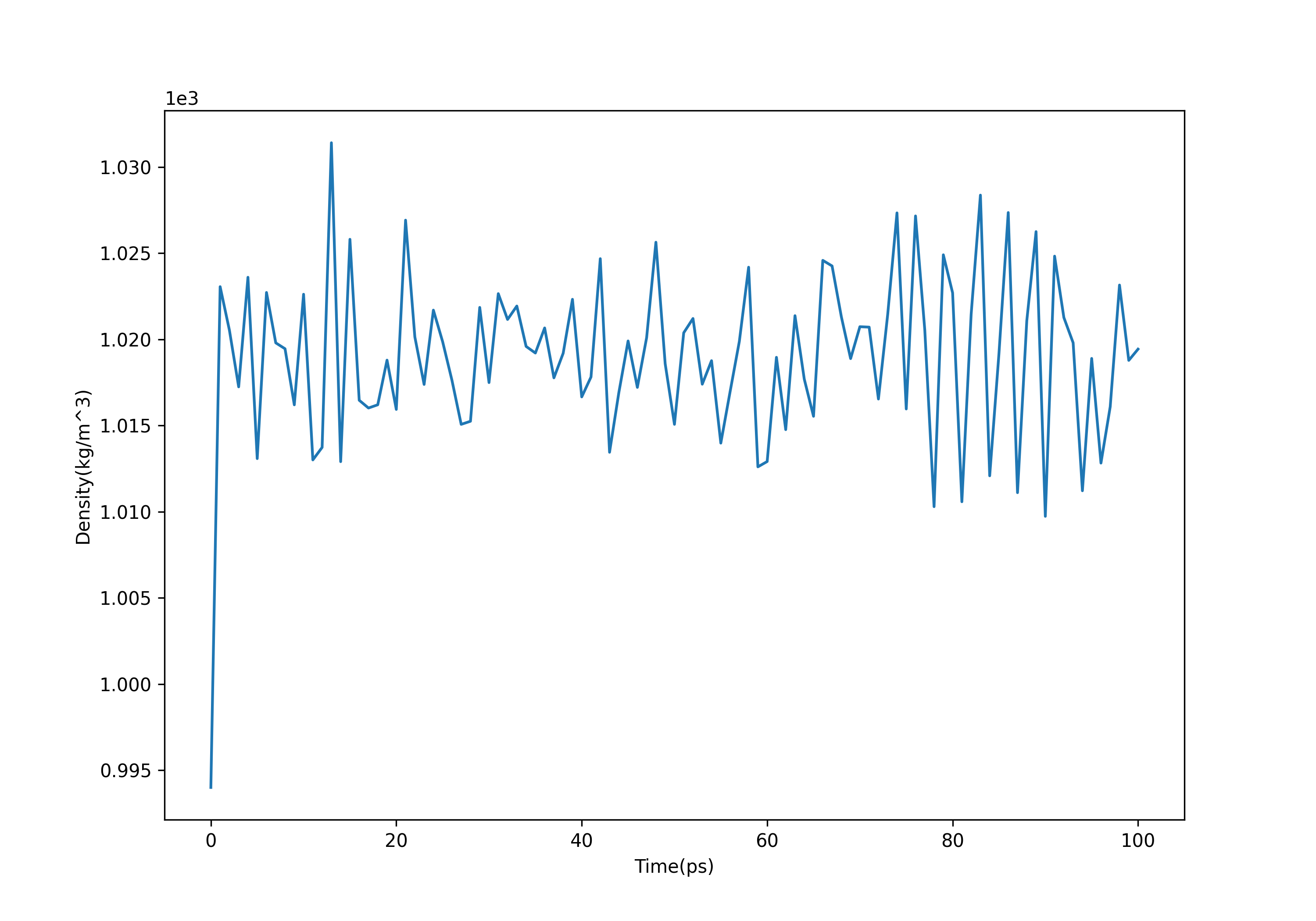
7. 正式模拟
gmx grompp -f md.mdp -c npt.gro -t npt.cpt -p topol.top -o md_0_1.tpr
gmx mdrun -deffnm md_0_1
md.mdp文件如下:
title = OPLS Lysozyme NPT equilibration
; Run parameters
integrator = md ; leap-frog integrator
nsteps = 500000 ; 2 * 500000 = 1000 ps (1 ns)
dt = 0.002 ; 2 fs
; Output control
nstxout = 0 ; suppress bulky .trr file by specifying
nstvout = 0 ; 0 for output frequency of nstxout,
nstfout = 0 ; nstvout, and nstfout
nstenergy = 5000 ; save energies every 10.0 ps
nstlog = 5000 ; update log file every 10.0 ps
nstxout-compressed = 5000 ; save compressed coordinates every 10.0 ps
compressed-x-grps = System ; save the whole system
; Bond parameters
continuation = yes ; Restarting after NPT
constraint_algorithm = lincs ; holonomic constraints
constraints = h-bonds ; bonds involving H are constrained
lincs_iter = 1 ; accuracy of LINCS
lincs_order = 4 ; also related to accuracy
; Neighborsearching
cutoff-scheme = Verlet ; Buffered neighbor searching
ns_type = grid ; search neighboring grid cells
nstlist = 10 ; 20 fs, largely irrelevant with Verlet scheme
rcoulomb = 1.0 ; short-range electrostatic cutoff (in nm)
rvdw = 1.0 ; short-range van der Waals cutoff (in nm)
; Electrostatics
coulombtype = PME ; Particle Mesh Ewald for long-range electrostatics
pme_order = 4 ; cubic interpolation
fourierspacing = 0.16 ; grid spacing for FFT
; Temperature coupling is on
tcoupl = V-rescale ; modified Berendsen thermostat
tc-grps = Protein Non-Protein ; two coupling groups - more accurate
tau_t = 0.1 0.1 ; time constant, in ps
ref_t = 300 300 ; reference temperature, one for each group, in K
; Pressure coupling is on
pcoupl = Parrinello-Rahman ; Pressure coupling on in NPT
pcoupltype = isotropic ; uniform scaling of box vectors
tau_p = 2.0 ; time constant, in ps
ref_p = 1.0 ; reference pressure, in bar
compressibility = 4.5e-5 ; isothermal compressibility of water, bar^-1
; Periodic boundary conditions
pbc = xyz ; 3-D PBC
; Dispersion correction
DispCorr = EnerPres ; account for cut-off vdW scheme
; Velocity generation
gen_vel = no ; Velocity generation is off
8.分析
(1)去除周期边界条件
gmx trjconv -s md_0_1.tpr -f md_0_1.xtc -o md_0_1_noPBC.xtc -pbc mol -center #选择1.protein
(2)计算RMSD
gmx rms -s md_0_1.tpr -f md_0_1_noPBC.xtc -o rmsd.xvg -tu ns #选择4.backbone
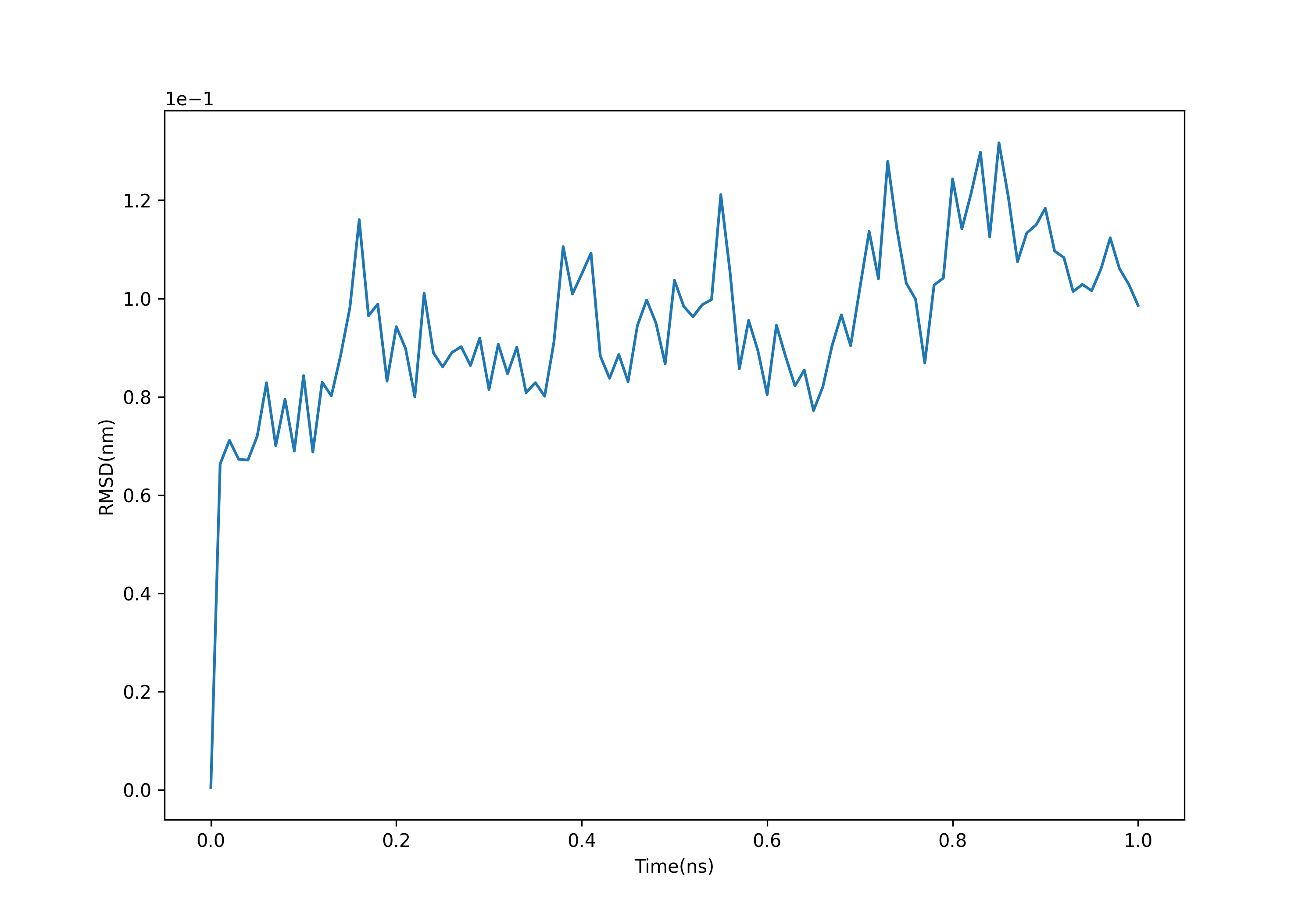 可以发现RMSD逐渐趋于0.1nm附近,这个足够小的值表明了蛋白质结构很稳定。
可以发现RMSD逐渐趋于0.1nm附近,这个足够小的值表明了蛋白质结构很稳定。
(3)计算回旋半径
gmx gyrate -s md_0_1.tpr -f md_0_1_noPBC.xtc -o gyrate.xvg #选择1.protein
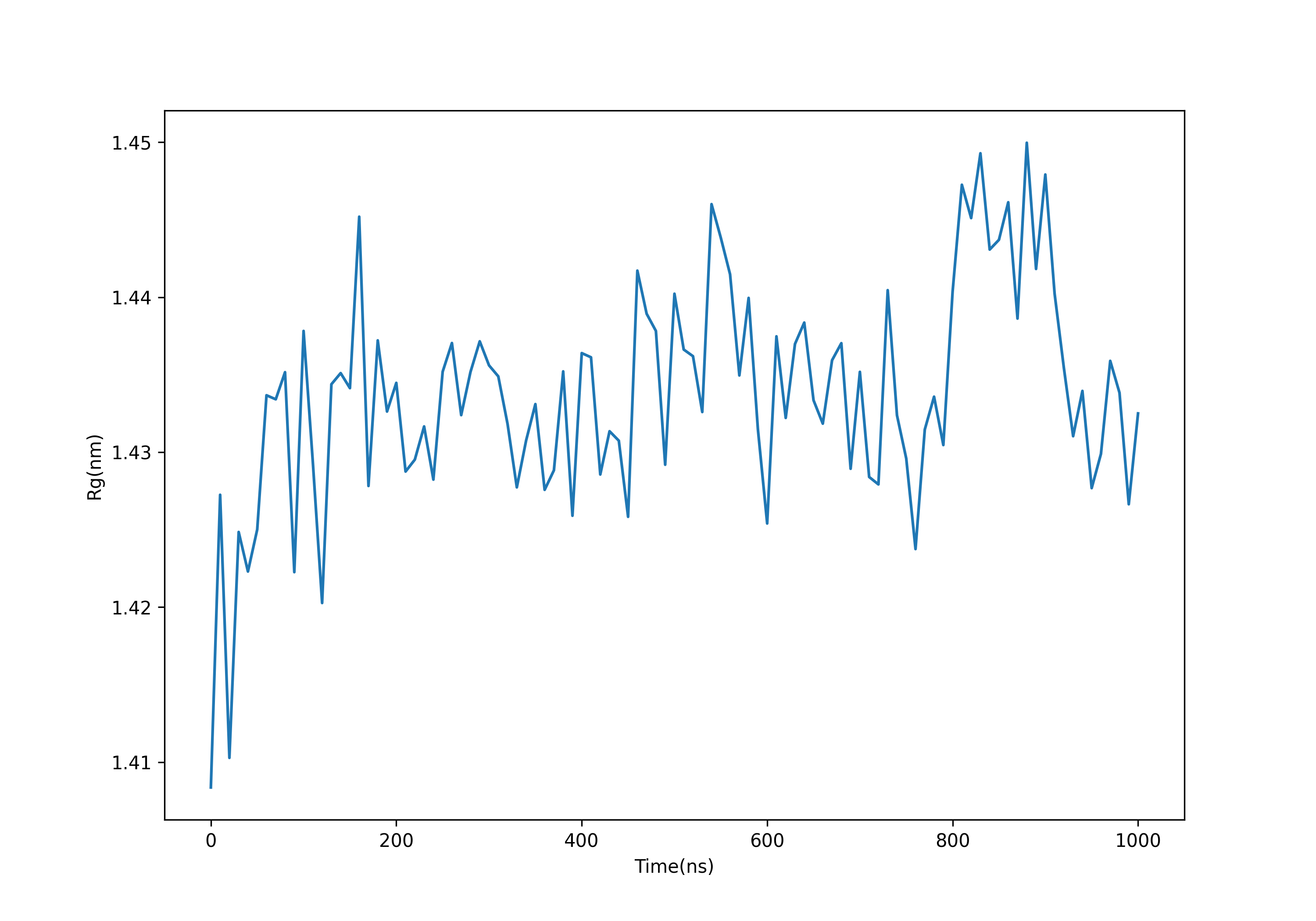 可以发现回旋半径逐渐趋于一个稳定的值,表明蛋白质可以稳定地保持折叠。
可以发现回旋半径逐渐趋于一个稳定的值,表明蛋白质可以稳定地保持折叠。
(4)可视化